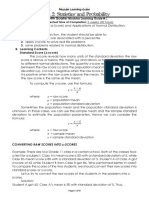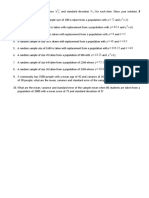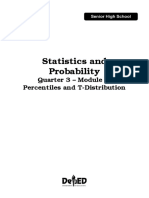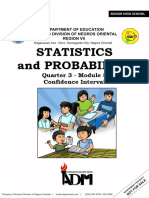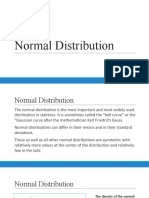100%(1)100% found this document useful (1 vote)
1K viewsHypothesis Testing: Z-Test & T-Test
Hypothesis Testing: Z-Test & T-Test
Uploaded by
Von Edrian PaguioThis document discusses hypothesis testing using the z-test and t-test. It provides examples of stating the null and alternative hypotheses, determining significance levels, finding critical values, computing test statistics, and making conclusions about whether to reject the null hypothesis. For the z-test, it shows how to calculate the test statistic z. For the t-test, it explains how to use the t-table to find the critical value based on degrees of freedom and the type of test (one-tailed or two-tailed). Practice problems demonstrate applying these steps to hypothetical data sets.
Copyright:
© All Rights Reserved
Available Formats
Download as PPTX, PDF, TXT or read online from Scribd
Hypothesis Testing: Z-Test & T-Test
Hypothesis Testing: Z-Test & T-Test
Uploaded by
Von Edrian Paguio100%(1)100% found this document useful (1 vote)
1K views11 pagesThis document discusses hypothesis testing using the z-test and t-test. It provides examples of stating the null and alternative hypotheses, determining significance levels, finding critical values, computing test statistics, and making conclusions about whether to reject the null hypothesis. For the z-test, it shows how to calculate the test statistic z. For the t-test, it explains how to use the t-table to find the critical value based on degrees of freedom and the type of test (one-tailed or two-tailed). Practice problems demonstrate applying these steps to hypothetical data sets.
Original Title
STATQ2_2-3
Copyright
© © All Rights Reserved
Available Formats
PPTX, PDF, TXT or read online from Scribd
Share this document
Did you find this document useful?
Is this content inappropriate?
This document discusses hypothesis testing using the z-test and t-test. It provides examples of stating the null and alternative hypotheses, determining significance levels, finding critical values, computing test statistics, and making conclusions about whether to reject the null hypothesis. For the z-test, it shows how to calculate the test statistic z. For the t-test, it explains how to use the t-table to find the critical value based on degrees of freedom and the type of test (one-tailed or two-tailed). Practice problems demonstrate applying these steps to hypothetical data sets.
Copyright:
© All Rights Reserved
Available Formats
Download as PPTX, PDF, TXT or read online from Scribd
Download as pptx, pdf, or txt
100%(1)100% found this document useful (1 vote)
1K views11 pagesHypothesis Testing: Z-Test & T-Test
Hypothesis Testing: Z-Test & T-Test
Uploaded by
Von Edrian PaguioThis document discusses hypothesis testing using the z-test and t-test. It provides examples of stating the null and alternative hypotheses, determining significance levels, finding critical values, computing test statistics, and making conclusions about whether to reject the null hypothesis. For the z-test, it shows how to calculate the test statistic z. For the t-test, it explains how to use the t-table to find the critical value based on degrees of freedom and the type of test (one-tailed or two-tailed). Practice problems demonstrate applying these steps to hypothetical data sets.
Copyright:
© All Rights Reserved
Available Formats
Download as PPTX, PDF, TXT or read online from Scribd
Download as pptx, pdf, or txt
You are on page 1of 11
Hypothesis Testing
Z-TEST & T-TEST
Review
State the null and alternative hypothesis.
1. The average room rate in hotels in a certain region is $82.53. A travel agent
believes that the average in a particular resort area is different.
◦ H0 : μ = 82.53, Ha : μ ≠ 82.53
2. The average farm size in a predominately rural state was 69.4 acres. The
secretary of agriculture of that state asserts that it is less today.
◦ H0 : μ = 69.4, Ha : μ < 69.4
Z-Test
1. State the Hypotheses
2. Determine the Level of Significance
3. Determine the critical value and the rejection region
4. State the decision rule
5. Compute the test statistic (Z)
◦ Z=
6. Formulate the decision
Example
A diet clinic states that there is an average loss of 24 pounds for those who stay
on the program for 20 weeks. The standard deviation is 5 pounds. The clinic tries
a new diet, reducing salt intake to see whether that strategy will produce a
greater weight loss. A group of 40 volunteers loses an average of 16.3 pounds
each over 20 weeks. Should the clinic change the new diet? Use α = 0.05.
1. State the Hypothesis
◦ H0 : μ = 24, Ha : μ > 24
2. Determine the Level of Significance
◦ α = 0.05 (right-tailed)
Example
3. Determine the critical value and the rejection region.
◦ Critical Value = 1.65
4. State the Decision Rule
◦ Reject H0 if Z > 1.65
5. Compute the test statistic (Z)
◦ Z=
◦ Z= 1.65
◦ Z=
6. Formulate conclusion: Do not Reject H0
Practice
Practice
a. Critical Value = 1.96
a. Z = 2.59
b. Reject H0
b. Critical Value = -1.65
a. Z = 2.59
b. Do not reject H0
T-Test
1. State the Hypotheses
2. Determine the Level of Significance
3. Determine the critical value and the rejection region
4. State the decision rule
5. Compute the test statistic (T)
◦ Z=
6. Formulate the decision
Determining the Critical Value (T-Test)
Parts of the T-Table
◦ Degrees of Freedom (d.f.) = Sample Size – 1
◦ Significance Level ()
To determine the Critical Value
1. Locate the degree of freedom (First column on the right)
2. Identify the level of significance (Two tailed/One tailed)
3. Find the intersection
Practice
Practice
a. Critical Value = 2.797 (two-tailed)
◦ T=
◦ Do not reject the null hypothesis
b. Critical Value = 2.492 (right-tailed)
◦ T=
◦ Do not reject the null hypothesis
You might also like
- Unit I Lesson 3 Computing The Mean of A Discrete Probability DistributionDocument24 pagesUnit I Lesson 3 Computing The Mean of A Discrete Probability DistributionBernadette Remigio - Jovellanos100% (1)
- Module 3 in Business MathDocument12 pagesModule 3 in Business MathJiro DomantayNo ratings yet
- SHS Statistics and Probability Q3 Mod1 Random Variables and v4Document41 pagesSHS Statistics and Probability Q3 Mod1 Random Variables and v4Charmian100% (2)
- Module 3 - StatisticsDocument27 pagesModule 3 - StatisticsRoussel PalmariaNo ratings yet
- STAT 1013 Statistics: Week 12Document48 pagesSTAT 1013 Statistics: Week 12Angelo Valdez33% (3)
- This Study Resource Was: Statistics and ProbabilityDocument3 pagesThis Study Resource Was: Statistics and ProbabilityRemar Jhon Paine50% (2)
- Length of Confidence and Appropriate Sample Size: Melc Competency CodeDocument11 pagesLength of Confidence and Appropriate Sample Size: Melc Competency CodeErnie LahaylahayNo ratings yet
- Use The Answer Sheet Provided and Shade The Letter of The Coorect AnswerDocument2 pagesUse The Answer Sheet Provided and Shade The Letter of The Coorect AnswerPhilline Grace Jaranilla100% (1)
- Confidence Intervals For The Population Mean When Is UnknownDocument18 pagesConfidence Intervals For The Population Mean When Is UnknownArvinEnriquezNo ratings yet
- Stat and Prob - Q4 - Week 4 - Module 4 - Drawing Conclusion About Population Mean Based On Test Statistic Value and Critical RegionDocument18 pagesStat and Prob - Q4 - Week 4 - Module 4 - Drawing Conclusion About Population Mean Based On Test Statistic Value and Critical RegionBensroy PitulanNo ratings yet
- Illustrating The Central Limit Theorem: LessonDocument16 pagesIllustrating The Central Limit Theorem: Lessonaiza100% (1)
- Stat and Prob - Q4 Week 4 - Module 12 Hilario GarciaDocument18 pagesStat and Prob - Q4 Week 4 - Module 12 Hilario Garciagabezarate071100% (1)
- Unit II Lesson 2 Understanding The Z-ScoresDocument14 pagesUnit II Lesson 2 Understanding The Z-ScoresBernadette Remigio - JovellanosNo ratings yet
- PSUnit IV Lesson 2 Understanding Confidence Interval Estimates For The Sample MeanDocument18 pagesPSUnit IV Lesson 2 Understanding Confidence Interval Estimates For The Sample MeanJaneth Marcelino0% (1)
- Computing The Mean of A Discrete Probability DistributionDocument51 pagesComputing The Mean of A Discrete Probability DistributionKathleen RafananNo ratings yet
- Statistics & Probability: Quarter 3 - Module 3: Mean and Variance of A Discrete Random VariableDocument19 pagesStatistics & Probability: Quarter 3 - Module 3: Mean and Variance of A Discrete Random VariableApril Joy Lascuña67% (3)
- Statistics & Probability Q3 - Week 5-6Document16 pagesStatistics & Probability Q3 - Week 5-6Rayezeus Jaiden Del RosarioNo ratings yet
- Percentile and The T-Distribution: Melc Competency CodeDocument8 pagesPercentile and The T-Distribution: Melc Competency CodeErnie LahaylahayNo ratings yet
- Lesson 8:: Determining ProbabilitiesDocument56 pagesLesson 8:: Determining ProbabilitiesTrice DomingoNo ratings yet
- Math 2: Statistics and Probability: Modular Learning GuideDocument8 pagesMath 2: Statistics and Probability: Modular Learning GuideMichael John LozanoNo ratings yet
- Stats&Prob - WEEK 2&3Document2 pagesStats&Prob - WEEK 2&3Ji Pao100% (2)
- Formulating Null and Alternative Hypothesis20 21Document53 pagesFormulating Null and Alternative Hypothesis20 21POSUGAC, John Denver PNo ratings yet
- Statistics and Probability: Quarter 2 Week 4: Entry BehaviourDocument6 pagesStatistics and Probability: Quarter 2 Week 4: Entry BehaviourVic TivarNo ratings yet
- Weekly Learning Activity Sheets 3Document6 pagesWeekly Learning Activity Sheets 3maricel sulapasNo ratings yet
- What I Can Do Hypothesis Testing InfographicDocument1 pageWhat I Can Do Hypothesis Testing InfographicRheanna Marie DoriaNo ratings yet
- Statistics and Probability Quarter 2 - Module 3: For Senior High SchoolDocument18 pagesStatistics and Probability Quarter 2 - Module 3: For Senior High SchoolAngelo IvanNo ratings yet
- Statistics and Probability: Learner'S Activity Sheet Quarter 3 - Week 5: Sampling Distribution of Sample MeansDocument10 pagesStatistics and Probability: Learner'S Activity Sheet Quarter 3 - Week 5: Sampling Distribution of Sample MeansRuben100% (1)
- Worksheet 4 - Mean and Variance of Sampling DistributionDocument2 pagesWorksheet 4 - Mean and Variance of Sampling DistributionRey SteveNo ratings yet
- Lesson 2.3 Standard Normal Curve and Z ScoresDocument18 pagesLesson 2.3 Standard Normal Curve and Z ScoresKlarence Timothy Pineda BundangNo ratings yet
- Computing The Point Estimate of The Population Proportion PDocument12 pagesComputing The Point Estimate of The Population Proportion PWade NakaharaNo ratings yet
- PR 1 LP 2Document7 pagesPR 1 LP 2Jesryl Remerata OrtegaNo ratings yet
- Illustration of Limit TheoremsDocument28 pagesIllustration of Limit TheoremsRobert ClavoNo ratings yet
- Exploring More Elements On Hypothesis TestingDocument16 pagesExploring More Elements On Hypothesis TestingIce BearNo ratings yet
- Stat and Prob - Q4 - Mod8 - Solving Problems Involving Test of Hypothesis On Population MeanDocument22 pagesStat and Prob - Q4 - Mod8 - Solving Problems Involving Test of Hypothesis On Population MeanFrancine DaranciangNo ratings yet
- Topic 18 Identifying The Appropriate Test Statistics Involving Population MeanDocument6 pagesTopic 18 Identifying The Appropriate Test Statistics Involving Population MeanPrincess VernieceNo ratings yet
- 14chap 1.5 Problems On Normal DistributionDocument14 pages14chap 1.5 Problems On Normal DistributionNyah Margarett100% (2)
- PSUnit IV Lesson 1 Computing The Point Estimate of A Population MeanDocument20 pagesPSUnit IV Lesson 1 Computing The Point Estimate of A Population MeanJaneth MarcelinoNo ratings yet
- Statistics and Probability: Quarter 3 - Module 7: Percentiles and T-DistributionDocument17 pagesStatistics and Probability: Quarter 3 - Module 7: Percentiles and T-DistributionYdzel Jay Dela TorreNo ratings yet
- 03 Teaching Guide - Business Math - Problems (ABM - BM11FO-Ic-4. Id-5) - TEDocument7 pages03 Teaching Guide - Business Math - Problems (ABM - BM11FO-Ic-4. Id-5) - TEJoyen AtilloNo ratings yet
- Learning Activity Sheets-Pre Cal - (Week 2)Document1 pageLearning Activity Sheets-Pre Cal - (Week 2)Dominic Dalton CalingNo ratings yet
- Statistics & Probability Week 1-2Document16 pagesStatistics & Probability Week 1-2AyenNo ratings yet
- Stat Prob Q3 Module 8Document30 pagesStat Prob Q3 Module 8Sonnel Calma50% (2)
- General Mathematics: Logical OperatorsDocument11 pagesGeneral Mathematics: Logical OperatorsSammy PerezNo ratings yet
- Lesson 2-08 Properties of Normal DistributionsDocument18 pagesLesson 2-08 Properties of Normal DistributionsJamiefel Pungtilan100% (3)
- Modified Basic Cal - Q3 - Module 1Document28 pagesModified Basic Cal - Q3 - Module 1Abigail GarciaNo ratings yet
- Stat and Prob Q3 Week 5 Mod5 Carla CatherineDocument20 pagesStat and Prob Q3 Week 5 Mod5 Carla CatherineCharlene Binasahan100% (2)
- SP Q3 Week 9Document25 pagesSP Q3 Week 9Christine Aira Formanes100% (1)
- Pre-Calculus Q2 Module 9Document7 pagesPre-Calculus Q2 Module 9Prince Reinier JonNo ratings yet
- Compilation of Lessons and ActivitiesDocument37 pagesCompilation of Lessons and ActivitiesMara M. LabanderoNo ratings yet
- Module 23 Basic Concepts in Hypothesis TestingDocument3 pagesModule 23 Basic Concepts in Hypothesis TestingAlayka Mae Bandales LorzanoNo ratings yet
- 2math 4Document30 pages2math 4Felonia Mekaell100% (1)
- Demo StatDocument5 pagesDemo StatCalventas Tualla Khaye JhayeNo ratings yet
- Topic 13 Percentiles and T-Distribution PDFDocument5 pagesTopic 13 Percentiles and T-Distribution PDFPrincess VernieceNo ratings yet
- Module 6 - Normal DistributionDocument14 pagesModule 6 - Normal DistributionJesusima Bayeta Albia0% (2)
- Basic Cal Q3 Module 7Document23 pagesBasic Cal Q3 Module 7Jessa Cuanan Calo100% (1)
- Quarter 4 - Week 1 & 2: Length of Confidence Interval and Appropriate Sample SizeDocument9 pagesQuarter 4 - Week 1 & 2: Length of Confidence Interval and Appropriate Sample SizeJennifer MagangoNo ratings yet
- Learning Activity Sheet 4.5Document4 pagesLearning Activity Sheet 4.5Clara ButacNo ratings yet
- Z-Test For MeanDocument15 pagesZ-Test For MeanSaqib ButtNo ratings yet
- Section V Notes With Answers - PDF BDocument8 pagesSection V Notes With Answers - PDF BDeivid William TorresNo ratings yet
- CH 7Document36 pagesCH 7Legese TusseNo ratings yet
- Estate Tax ReviewerDocument39 pagesEstate Tax ReviewerVon Edrian PaguioNo ratings yet
- Proving of Inequalities in A TriangleDocument10 pagesProving of Inequalities in A TriangleVon Edrian PaguioNo ratings yet
- Stat-Q2 1Document8 pagesStat-Q2 1Von Edrian PaguioNo ratings yet
- Exterior Angle Inequality Theorem, Triangle Inequality Theorem, & Hinge TheoremDocument10 pagesExterior Angle Inequality Theorem, Triangle Inequality Theorem, & Hinge TheoremVon Edrian PaguioNo ratings yet
- The Time Travelers WifeDocument3 pagesThe Time Travelers WifeVon Edrian PaguioNo ratings yet
- Stat 7 PracticeDocument2 pagesStat 7 PracticeVon Edrian PaguioNo ratings yet
- ch10 ProblemsDocument8 pagesch10 ProblemsVon Edrian PaguioNo ratings yet
- Stat 3Document12 pagesStat 3Von Edrian PaguioNo ratings yet
- Central Limit Theorem: Sample Normal DistributionDocument6 pagesCentral Limit Theorem: Sample Normal DistributionVon Edrian Paguio0% (1)
- Standard Normal DistributionDocument10 pagesStandard Normal DistributionVon Edrian PaguioNo ratings yet
- Measures of Variability: Range, Interquartile Range, Variance, and Standard DeviationDocument13 pagesMeasures of Variability: Range, Interquartile Range, Variance, and Standard DeviationVon Edrian PaguioNo ratings yet
- Height F Cumulative F Class Mark (XM) F XM XM - MeanDocument2 pagesHeight F Cumulative F Class Mark (XM) F XM XM - MeanVon Edrian PaguioNo ratings yet
- Measures of Central Tendency: Mean, Median, & ModeDocument21 pagesMeasures of Central Tendency: Mean, Median, & ModeVon Edrian PaguioNo ratings yet
- The Muslim World: A Research StudyDocument14 pagesThe Muslim World: A Research StudyVon Edrian PaguioNo ratings yet
- Statistics IntroDocument17 pagesStatistics IntroVon Edrian PaguioNo ratings yet



















